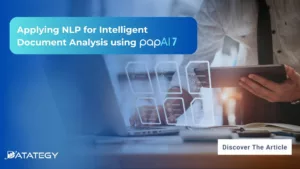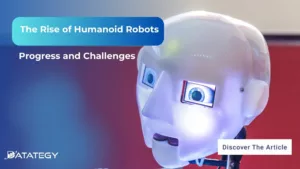Applying NLP for Intelligent Document Analysis using papAI 7 AI...
Read MoreDecoding AI: Artificial Intelligence Models in 2024
Table of Contents
ToggleIf artificial intelligence is the dominant topic today, AI models are the driving force behind it!
AI models are essential to the effectiveness and complexity of AI systems. These models are the brains behind the machines; they allow them to understand, process, and react to complicated tasks with a high degree of accuracy.
According to the latest studies, 65% of companies are already using AI internally, while another 74% are testing it.
Discover all the use cases from Datategy here.
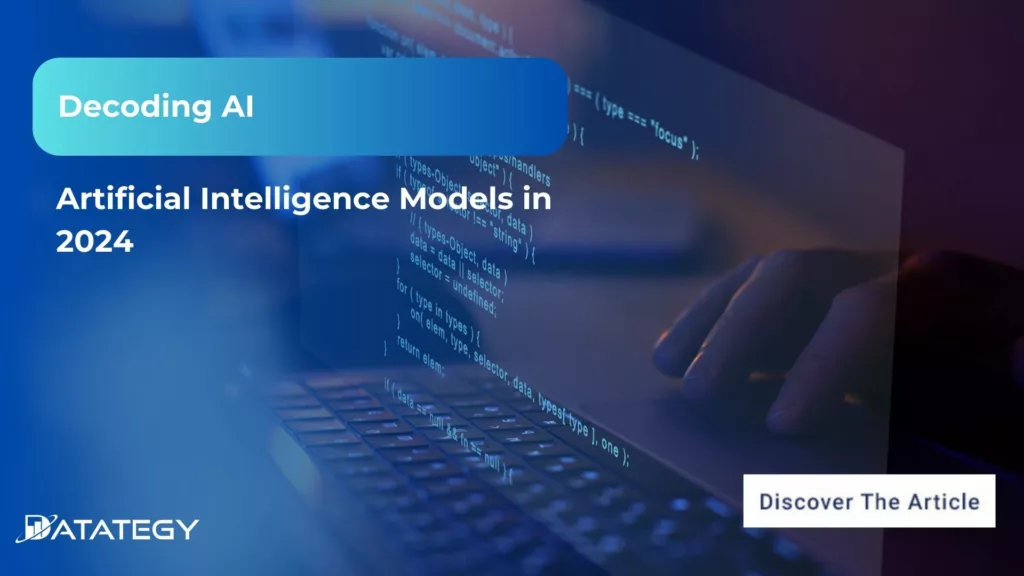
We will analyze the fundamental elements of these models, investigate how they are used in cutting-edge fields, and look at the most recent discoveries and developments that are transforming whole sectors.
Overview of Artificial Intelligence Models in 2024
Machine Learning Models
Systems can recognize patterns and make predictions without explicit programming thanks to machine learning models, which are computational algorithms. The objective of these models is to detect underlying patterns or trends that may be utilized for future forecasts by analyzing and interpreting data using statistical techniques.
The fundamental idea is to give computers the ability to grow with time, learn from mistakes, and become more proficient. This will enable them to adjust to new situations and make wise decisions based on the data collected during training.
These models fall into several categories, including reinforcement learning, supervised learning, and unsupervised learning. In supervised learning, the algorithm learns to map input data to matching output labels by training the model on labeled data. Unsupervised learning is examining links and patterns in unlabeled data to find hidden groupings or structures.
Through interactions with an environment, where the system learns to make decisions by getting feedback in the form of rewards or penalties, reinforcement learning focuses on training models.
Deep Learning Models
Multi-layered neural networks, or “deep neural networks,” are used in a subset of machine learning methods known as deep learning models. Rather than requiring explicit feature engineering, these models are made to automatically learn complex patterns and hierarchical representations from the data.
Deep neural networks are designed to extract increasingly complicated elements from data at each layer, giving the model cognitive abilities equivalent to those of humans.
Because deep learning is so good at tasks like speech recognition, picture identification, and natural language processing—where complicated data demands sophisticated and nuanced understanding—it has become more and more well-known.
How do you Choose the Right AI models to Use?
Understand Your Data
Choosing the best AI model requires an understanding of the nuances of your data. Start by doing a thorough analysis of the kinds of data you have available. Is it unstructured, like free text, photos, or music, or is it structured, with information clearly defined and arranged?
The models that are most suited to handle the unique properties of your data are selected using this first categorization as guidance.
Examine the quantity and caliber of your dataset in addition to its format. Consider the amount of data available for training; deep neural networks and other sophisticated models frequently benefit from greater datasets. Concurrently, think about the quality of your data; find and fix any outliers, missing numbers, or anomalies that might affect the way the model performs.
Consider Pre-Trained Models
Examining pre-trained models is a crucial phase in the model selection process that provides a calculated way to take use of current knowledge and hasten your AI project. Neural networks that have been extensively trained on large datasets for common tasks like speech recognition, picture recognition, and natural language processing are known as pre-trained models.
These models are strong instruments for a range of applications since they gather a great deal of information throughout the training process.
Pre-trained models have the important benefit of being a good place to start, particularly if there is a lack of labeled data available for your particular activity. Many areas and activities are covered by the libraries of pre-trained models offered by platforms such as Hugging Face and TensorFlow Hub. These models have acquired complex patterns and representations through their frequent training on enormous datasets.
Examine the Model's Performance
An important part of the selection process is assessing the performance of various AI models, as this has an immediate influence on how well the model solves your particular problem. Model performance indicators help you make decisions by giving you information about how successfully a model generalizes to new, untested data.
Examine the performance indicators and pertinent benchmarks that are connected to each potential model first. Recognize the metrics—such as accuracy, precision, recall, F1 score, and area under the receiver operating characteristic (ROC) curve—that are frequently employed in the context of your problem.
Metrics may be prioritized differently depending on the job; for example, sensitivity and specificity may be crucial in a medical diagnosis situation.
Overview of AI Models in 2024
1- CQR (Conditional Quantile Regression)
CQR is one of the AI models that uses statistical and mathematical frameworks to process data. They adjust their behavior over time to enhance performance by learning from patterns in the data. In particular, CQR emphasizes capturing different quantiles of the response variable’s distribution.
Random Forest
In machine learning, Random Forest is a powerful tool that makes reliable predictions by utilizing the advantages of ensemble methods. Fundamentally, during the training stage, this model builds an ensemble of decision trees. Every decision tree individually discovers patterns in the dataset after being trained on a randomized subset of the characteristics and data.
When it comes to managing intricate datasets, preventing overfitting, and providing excellent accuracy, Random Forest shines. It is the preferred option for many applications, including image identification, finance, and healthcare, because of its versatility and capacity to detect a wide range of patterns.
With the help of several decision trees working in harmony, this ensemble model exhibits the collective intelligence that can be used to make predictions.
Gradient Boosting
Gradient Boosting is a powerful ensemble technique that uses a sequential learning strategy to repeatedly improve model predictions. The key to this approach is building a sequence of models, each of which fixes the mistakes of the one before it. Gradient Boosting, in contrast to Random Forest, develops models one after the other to maximize accuracy and reduce residual errors.
XGBoost and LightGBM are two notable examples of Gradient Boosting systems that are highly regarded for their effectiveness and scalability. Regularisation methods and parallel processing are combined in XGBoost to improve speed and prediction accuracy, while LightGBM provides a learning method based on histograms to maximize computing resources.
2- Clustering
Artificial intelligence clustering methods combine comparable data points together according to innate patterns or similarities. In unsupervised learning, when the computer finds the structure in the data without the need for predetermined labels, these models are essential:
Mean Shift Clustering
By focusing on data point density, Mean Shift Clustering is an effective unsupervised learning approach that may reveal hidden patterns in datasets. Mean Shift functions in a non-parametric way, altering centroids dynamically to converge towards regions of higher point density, in contrast to conventional clustering techniques.
The voyage of the method starts with kernel estimation, which evaluates the probability density surrounding each data point using a selected kernel function. The basis for the iterative centroid shifting procedure is laid by this first stage.
Centroids are steered towards areas of higher data density during the iterative phase by adjusting them towards the mean of points inside the defined kernel. Centroids stabilize at convergence, a sign that the algorithm has successfully identified clusters after this process continues.
K-means Clustering
K-means The foundation of unsupervised learning is clustering, which provides a popular and effective method for dividing data into discrete groups. K-means’s core technique is its centroid-based approach, in which cluster assignments are iteratively refined by the algorithm to minimize the sum of squared distances inside a cluster.
Centroids are initialized, data points are assigned to the closest centroid, centroids are updated depending on the average of points within each cluster, and the procedure is repeated until convergence or a certain number of times.
DBSCAN
Among clustering algorithms, DBSCAN (Density-Based Spatial Clustering of Applications with Noise) is unique in that it provides a reliable way to discover clusters of different forms and manage outliers. DBSCAN analyses the data based on point density rather than preset cluster forms, which makes it especially useful for datasets with potentially irregularly structured clusters.
The method works by finding core points—points with a minimal number of neighbors within a given radius—and then joining these core locations with their neighbors who can be reached to form clusters.
3- Time Series Forecasting
Predicting future values by using existing data sequences is a crucial use of artificial intelligence known as time series forecasting. Numerous models have been created to address the complexities of time-dependent data, offering academics and organizations insightful knowledge about patterns, trends, and future results.
ARIMA forecaster
Regarded as a pioneer in time series forecasting, the ARIMA (AutoRegressive Integrated Moving Average) forecaster is praised for its capacity to grasp intricate temporal relationships in sequential data. ARIMA is a powerful tool for modeling and forecasting a wide range of time series patterns. It consists of three main components: AutoRegressive (AR), Integrated (I), and Moving Average (MA).
The AutoRegressive part emphasizes the temporal dependencies within the series by evaluating the linear relationship between the past values and the present observation.
A consistent and steady dataset for modeling is ensured by the integrated component’s differentiation of the series, which tackles non-stationarity. At last, the Moving Average element delves into the relationship between the present observation and the residual errors from earlier observations, skillfully identifying brief variations in the time series.
Exponential Smoothing (ETS)
Exponential Smoothing is a family of techniques that addresses the difficulties associated with time series forecasting.
It falls within the larger category of Exponential Smoothing State Space Models (ETS). ETS models offer a versatile framework for capturing trends, seasonality, and abnormalities in data because of their responsiveness to a wide range of temporal patterns. Among the ETS family, the Triple Exponential Smoothing model (Holt-Winters) is unique in that it takes a holistic approach to forecasting, including seasonality, trend, and level components.
Prophet
Facebook’s Prophet proves to be a potent instrument for time series forecasting, providing analysts and data scientists with a reliable and easy-to-use solution. Acknowledging the intricacies of actual time series data, Prophet was designed to manage daily observations containing abnormalities, like vacations and special occasions.
Prophet is unique in that it can adapt to these outside influences with ease, giving a more precise and lifelike depiction of temporal patterns.
Because the model’s architecture includes elements for identifying trends, holidays, and seasonality, it is ideally suited for scenarios in which the data displays dynamic and non-linear patterns.
How to choose the best AI solution for your data project?
In this white paper, we provide an overview of AI solutions on the market. We give you concrete guidelines to choose the solution that reinforces the collaboration between your teams.
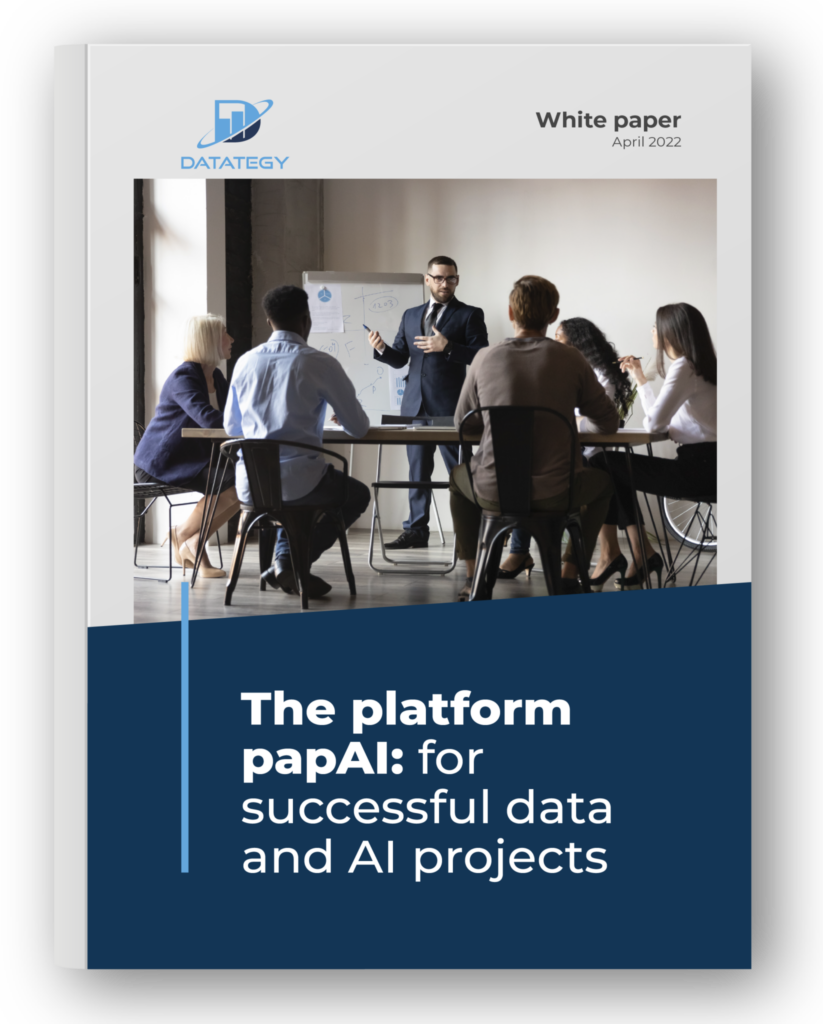
4- Survival Models
To comprehend and forecast how long it will take for an interesting event to occur, survival models are essential. These models are especially common in dependability analysis, finance, and medical research, where the goal is to determine how long something will take to happen—such as death, failure, or the manifestation of a certain consequence.
The Cox Proportional Hazard model and the Weibull model are two well-known survival models.
Cox Proportional Hazard Model
A semi-parametric survival model called the Cox Proportional Hazard model is frequently used to evaluate the impact of variables on the hazard function, which expresses the instantaneous risk of an occurrence at any given time. Because it does not assume a particular shape for the baseline hazard, this model may be used to capture complex survival patterns with flexibility.
Through allowing variables to double the effect on the hazard, the Cox model reveals how various factors affect the duration of survival. That’s why it’s so useful in situations when the risk rates fluctuate over time and scientists are trying to figure out what causes such fluctuations.
Weibull Model
Renowned for its adaptability in characterizing different hazard function forms is the parametric survival model, Weibull. Exponential and non-exponential hazard patterns are supported by the introduction of the Weibull distribution. When hazard rates predictably fluctuate over time, the model is especially helpful.
Weibull models provide researchers a more sophisticated understanding of how factors affect the survival distribution and are frequently used when the assumption of constant hazard is not feasible. When forecasting time-to-event outcomes is critical for risk assessment and decision-making, the Weibull model is a powerful tool due to its versatility and capacity to capture a variety of survival patterns.
5- Regression Models
In the field of artificial intelligence, regression models are crucial instruments that facilitate the examination and forecasting of correlations among variables. The concepts and features of three well-known regression models are examined here: stochastic gradient descent (SGD), support vector machines (SVM), and linear regression.
Linear Regression
To create a linear relationship between the dependent variable and one or more independent variables, the fundamental model of linear regression is used. When the data shows a linear pattern, the model works very well since it assumes that the connection may be represented by a straight line. A useful tool for making predictions and comprehending how factors affect results, linear regression estimates coefficients to reveal information about the direction and strength of associations. For all its simplicity and interpretability, linear regression is only useful when the connection at work is linear.
Support Vector Machines (SVM)
Overcoming the limitations of linear connections, Support Vector Machines are a potent regression and classification technology. In order to forecast the target variable with a certain margin of error in regression, SVM looks for the best hyperplane that maximises the margin between classes. With kernel functions, SVM can map data into higher-dimensional spaces and handle non-linear connections with ease. When dealing with complicated and non-linear underlying patterns, support vector mapping (SVM) is an effective method for defining decision boundaries.
Stochastic Gradient Descent (SGD)
One flexible optimization approach used in machine learning and regression is stochastic gradient descent. Using the gradients of the loss function with respect to the parameters, SGD iteratively optimizes the model parameters. SGD is especially useful in large dataset settings since it improves computing efficiency by updating parameters with only a portion of the data used in each iteration.
Because of this, it works effectively in situations where real-time updates are essential, such as online learning. SGD is widely used in regression assignments because of its efficiency and versatility, which provide a useful method for optimizing models in a variety of applications.
6- Binary Classification
When predicting whether an instance falls into one of two categories is the goal, binary classification models come in handy. Here, we examine some of the most significant binary classification models’ definitions and features.
Logistic Regression
the classification technique known as logistic regression is frequently used to binary outcomes. By translating the output via the logistic function to limit values between 0 and 1, it calculates the likelihood that an instance belongs to a specific class. In binary classification tasks, the model is an interpretable and essential tool since it classifies occurrences according to a predetermined threshold. When a linear relationship between the characteristics and the log-odds of the outcome is anticipated, logistic regression is very useful.
Decision Trees
A visible and straightforward method for binary categorization is provided by decision trees. By dividing the dataset recursively according to feature requirements, these models produced a structure resembling a tree. Decisions on which of the two categories to assign instances to are decided at each node.
Decision trees have the ability to automatically understand data and are skilled at identifying intricate linkages within the data. Nonetheless, overfitting is frequently reduced by using techniques like pruning and ensemble approaches (like Random Forests).
Support Vector Machines (SVM)
Backing Vector Machines are useful for binary classification in addition to regression. Finding the ideal hyperplane that maximally divides instances of various classes is the goal of support vector machines (SVM). SVM can handle non-linear correlations by utilising kernel functions, which gives it flexibility in capturing complex patterns. When classes are difficult to distinguish in the original feature space, support vector machines (SVM) perform very well.
papAI's AI Model Overview: Providing Businesses with Cutting-Edge Capabilities
papAI solution offers an extensive range of AI models across several disciplines to satisfy the specific needs of businesses. As part of papAI’s commitment to quality and performance, its AI models undergo rigorous training and validation procedures, ensuring their reliability and effectiveness.
Professionals in AI have developed sophisticated image classification, CQR, clustering, survival models, binary classification, time series forecasting, and regression models that provide businesses with a competitive advantage.
You may move your organization’s data-driven decision-making process forward by booking a papAI demo as soon as possible. Discover how to quickly realize the full potential of machine learning models by learning how our cutting-edge platform makes it easy to build up, manage, and monitor them.
During the demonstration, our experienced staff will walk you through papAI’s innovative features, streamlined workflow, and seamless connection.
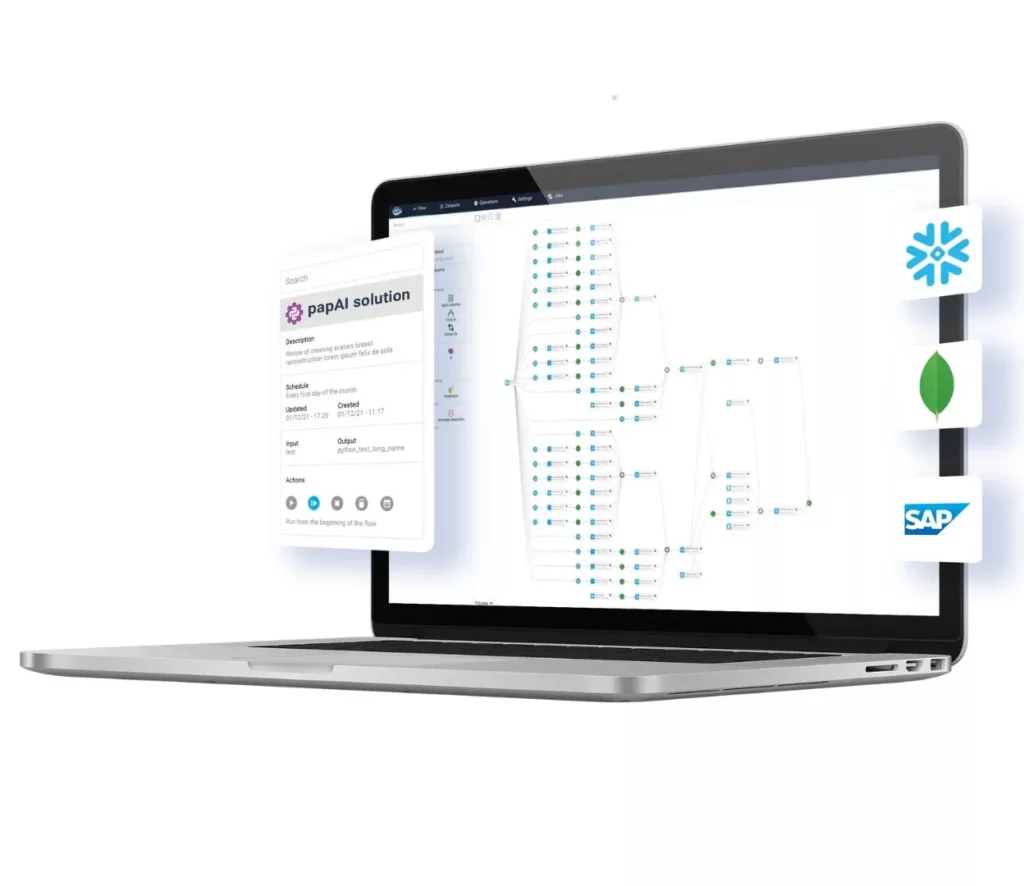
Interested in discovering papAI?
Our AI expert team is at your disposal for any questions
“DATATEGY EARLY CAREERS PROGRAM” With Samar CHERNI
“DATATEGY EARLY CAREERS PROGRAM” With Samar CHERNI Hello, my name...
Read MoreAI Origins: Yann LeCun
AI Origins: Yann LeCun Welcome to ”AI Origins “ series....
Read MoreThe Rise of Humanoid Robots: Progress and Challenges
The Rise of Humanoid Robots: Progress and Challenges Some humanoid...
Read More